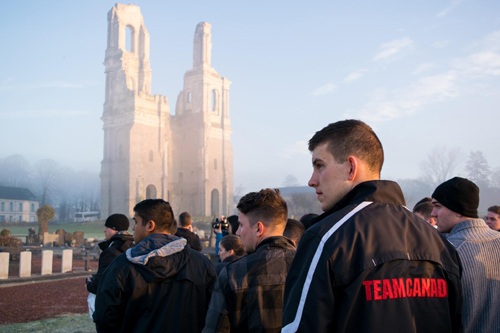 RMC Officer Cadets look out onto graves at the ruined tower of Mont-Saint-Eloi Abbey in France during the Annual Belgium-France Battlefield Tour. (OCdt Kevin Pathinather, OCdt Matthew Hammond, OCdt Anton Humeniuk, OCdt Morgan Holdway)
RMC Officer Cadets look out onto graves at the ruined tower of Mont-Saint-Eloi Abbey in France during the Annual Belgium-France Battlefield Tour. (OCdt Kevin Pathinather, OCdt Matthew Hammond, OCdt Anton Humeniuk, OCdt Morgan Holdway)Over the RMC Reading Week in February 2015, a group of 26 officer and naval cadets and faculty members of the Royal Military College of Canada travelled to the battlefields of France and Belgium, as part of the Battlefield Tour 2015. From February 14th to the 22nd, the students and professors travelled northern France and Belgium, visiting the great battlefields of the Somme, Vimy Ridge, Ypres, Dieppe, Juno beach, and more. At each location, the history professors Dr. Boire, Dr. Delaney and Dr. Coombs, pointed out significant features of the battlefield location, and asked the students to reflect on the planning that lead up to the attack, the leadership present on the battlefield, and the soldiers who made the ultimate sacrifice to defend Canada.
The battlefield tour provides officer cadets with the unique experience of being able to travel around Europe and witness firsthand the battle sites they are taught about in history courses. The nine-day schedule included trips to battle sites, Canadian and international monuments, countless Commonwealth, allied, and German cemetery sites, and allowed time at night for cadets to explore the cities. The cadets were able to see and touch the places where Canadian history was made, and could reflect on how the European towns and cities had rebuilt themselves after experiencing such great loss. To see how the farmers and citizens of northern France had rebuilt their lives on fields full of dead bodies and shrapnel, and how the people thrived on what used to be barren wasteland was truly inspiring.
After adjusting to the time difference in Paris on the first day of the trip, the tour began. The battle of the Somme was covered the first day, with trips to the Thiepval monument, the Newfoundland Regiment battlefield at Beaumont-Hamel, the Lochnagar crater, the armoured tank monument at Pozières, and the 22ième battle site at Courcelette. The beautiful clear day seemed inappropriate to some, to be so happy while viewing the battlefields on which so many Canadians lost their lives, and so to the cadets it served a sombre reminder of the price paid for their freedom. The beautiful weather did not continue the rest of the week.
The second day continued with the battlefields of the First World War. The morning fog following the cadets as they visited Mont Saint Eloi, the German cemetery “La Targette,” the Grange tunnels, Duffield craters, Vimy Ridge memorial, numerous battle fields of the four Canadian divisions, and concluded with the 8 pm ceremony at the Menin Gate in Ypres. This ceremonial playing of the Last Post has continued uninterrupted to the present day, save during the years of German occupation during the Second Wold War.
Tuesday was the last day to cover the battles of World War One, with visits to LCol MacRae’s place of inspiration for “In Flanders Fields” Essex farm, Passchendaele, the Brooding Soldier at Saint Julien, Tynecot cemetery, the PPCLI monument at Frezenberg, Amiens, and Dieppe. At each location the professors took great care to explain how each battle contributed to the overall war effort, the human cost, and the lessons the cadets should take great care to learn from. The cold and sobering day was completed when the cadets all traveled to the lovely port town of Dieppe, and spent the night exploring the town and reflecting on all that they had seen so far.
The next two days were spent travelling the beaches of the Dieppe and Juno beach operations, learning about why the locations were chosen, how the battles occurred, and the human cost to these operations. The visit to the Canadian Dieppe cemetery proved a particularly moving experience to every cadet and professor, with a reflective playing of Last Post by OCdt Page. The Thursday was spent tracing the steps of the Canadians on D-Day, from the Pegasus Bridge the 1CANPARA regiment landed at to the beaches of Juno, concluding at Gold Beach with a film about the construction of the Mulberry harbours.
The last day touring the battlefields was spent following the Canadian divisions during the July 1944 battles, moving from Bretteville to Falaise to Saint Lambert sur Dives, finally concluding at a Tiger IV monument in Vimoutiers. An emotional stop was made at the Abbaye des Ardennes, the site of the execution of 20 Canadian soldiers by members of the 12th SS Panzer division Hitlerjugend. The professors took the last day to stress to the cadets the importance of strong leadership and of learning from the past.
After spending the Saturday touring Paris, the cadets boarded the plane to return to Canada. Each cadet spent the long plane ride home reflecting on all that they had seen and learned while in Europe, humbled, matured, and more familiar with what Canada contributed to the First and Second World Wars.
The cadets and organisers of the Royal Military College of Canada’s Battlefield Tour 2015 would like to thank the RMC Foundation, without whom, the trip would not have been possible. This great experience has forever changed the lives of the cadets who traveled on it, and will doubtlessly contribute to their future successes as officers in the Canadian Armed Forces.